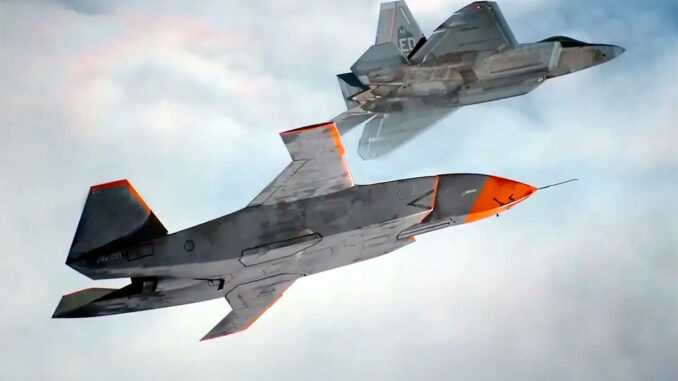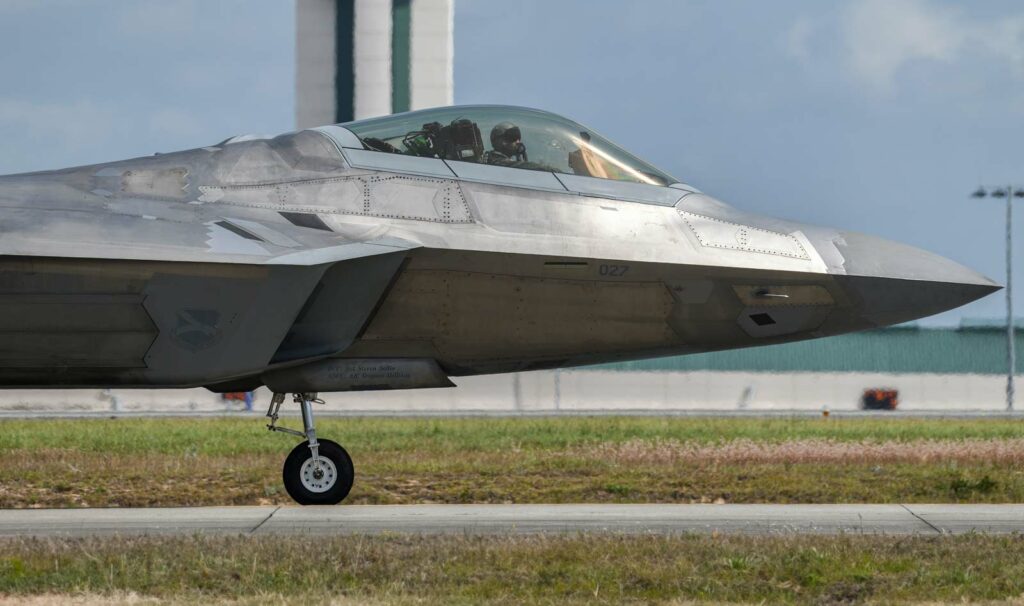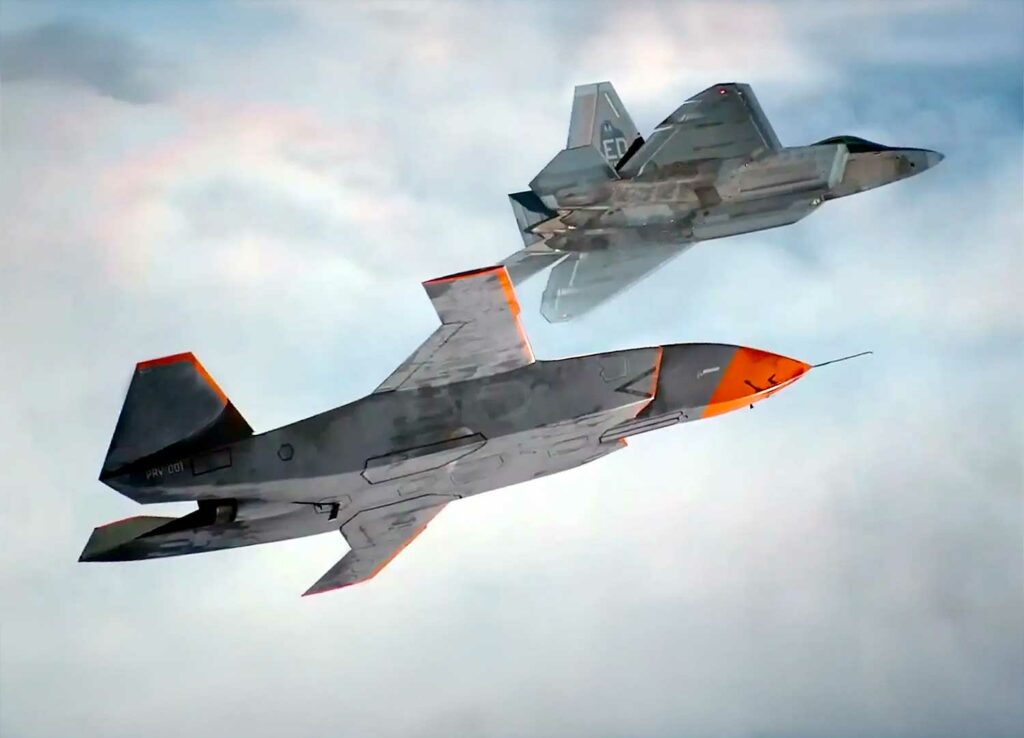
Technical analysis: how the F-22 will be equipped to fly future collaborative combat drones from 2026.
The F-22 Raptor will be specially equipped in 2026 with tactical tablets to pilot future Collaborative Combat Aircraft (CCA) drones. The US Air Force plans to equip 143 aircraft with control kits (approximately $86,000 per unit).. Two CCA prototypes (YFQ-42A and YFQ-44A) are the first in a potential fleet of 100 to 150 drones in Increment 1, with a target of nearly 1,000 units in the long term. This development will mark a major transition to an integrated man-machine concept and will pose challenges in terms of interoperability, autonomy, and training.
Installation of control systems in the Raptor
The US Air Force has confirmed its intention to equip almost its entire operational fleet of F-22 Raptors with control systems for collaborative combat drones (CCA) by the 2026 fiscal year. This decision is part of a program called Crewed Platform Integration, which aims to equip manned aircraft with a physical and software interface that will enable them to fly and supervise autonomous drones on missions.
Specifically, 143 F-22s (out of the 185 aircraft listed) will receive a CCA integration kit consisting of a tablet-type command terminal, specific cabling, dedicated communication software modules, and all technical support related to assembly, testing, validation, and operator training. The budget allocated amounts to approximately $14 million (€15 million), of which $12.2 million is specifically earmarked for the purchase of 142 tablets with associated cabling, bringing the unit cost to $86,218 per kit.
The choice of a touchscreen tablet as the main interface was based on several criteria: speed of implementation, compatibility with existing avionics architectures, low hardware footprint in the cockpit, and software scalability. Lockheed Martin, the F-22’s prime contractor, has already demonstrated the viability of this solution in tests conducted on simulators and during test flights on the F-35 and F-22, with the ability to manage multiple drones simultaneously from a single interface.
This minimalist integration does not require a major overhaul of the F-22’s onboard systems. It allows collaborative capability to be added to the Raptor without disrupting its core mission architecture, ensuring a balance between modernization, availability, and operational readiness. The option chosen by the USAF is therefore to test a major tactical concept at low cost before rolling it out more widely to other 5th and 6th generation platforms.

The operational Raptor fleet and its CCA potential
The current fleet of F-22 Raptors is small but strategically crucial for the US Air Force. Of the 185 aircraft built, 143 are currently combat-ready, with the remainder assigned to training, testing, or reserve duties. This fleet is both limited in size and valuable in terms of capability, which justifies the sustained efforts to extend its tactical relevance until the arrival of a 6th generation platform.
The introduction of collaborative combat drones (CCAs) into the F-22’s operational ecosystem is a clear attempt at mass compensation. Faced with potential adversaries capable of deploying hundreds of fighters—led by China with nearly 1,500 fighters in service, including more than 200 fifth-generation aircraft—the US Air Force is seeking to multiply its tactical effects by combining its manned aircraft with swarms of intelligent, less expensive, and potentially expendable drones.
In this configuration, the F-22 is no longer just a stealth interceptor, but becomes an advanced air coordination platform capable of commanding multi-vector missions: penetration into defended airspace, saturation attacks, electronic jamming, or reconnaissance missions. Equipping each combat aircraft with a drone control kit allows this capability to be distributed across the entire fleet without relying on a few specialized units. This ensures tactical flexibility and rapid deployment in any theater.
However, the reliability of this transition depends on the actual availability of the F-22s. However, according to several internal audits, more than 30% of the fleet is undergoing maintenance at any given time due to the complexity of the parts and the sensitivity of the stealth airframe. This means that of the 143 combat-coded aircraft, only about 100 are actually available at any given time.
This is why the US Air Force is counting on a gradual ramp-up. Each operational F-22 equipped with the CCA control system will be able to control two to four drones, depending on the configuration. If this ratio is achieved, the current fleet would be able to coordinate approximately 300 to 500 combat drones simultaneously. This projection, which is still theoretical, forms the basis of the concept of “assisted tactical massification,” based not on increasing the number of piloted aircraft, but on increasing the volume of engagement through autonomous intermediaries.
CCA prototypes and the US Air Force’s vision
The Collaborative Combat Aircraft (CCA) program is one of the pillars of the US Air Force’s capability renewal strategy for 2030. It aims to equip manned fighter platforms (F-22, F-35, future F-47) with direct support via remotely piloted or autonomous drones. This approach allows combat functions to be distributed, reduces the exposure of manned aircraft, and extends the tactical range of air missions.
Two prototypes are currently under development as part of Increment 1 of the CCA program:
- The YFQ-42A, designed by General Atomics, already known for its MALE platforms such as the MQ-9 Reaper. It is geared towards a profile optimized for stealth penetration and air-to-ground strikes.
- The YFQ-44A, developed by Anduril, aims for a more modular profile, capable of performing both offensive and ISR (intelligence, surveillance, reconnaissance) missions.
The USAF’s initial goal is to acquire between 100 and 150 units in Increment 1. In the longer term, this figure is expected to reach 1,000 drones of all generations (Increments 1, 2, 3, etc.), distributed among various mother platforms. This represents a paradigm shift in air force planning, which has traditionally focused on small fleets of high-performance piloted fighters.
The budget for the CCA program in 2026 is $870 million (≈€810 million), plus €15 million for integration on the F-22 and nearly $55 million for the Experimental Operations Unit (EOU) and the VENOM program, dedicated to autonomous testing. This budget allocation shows that the program is already industrialized across several areas: construction, command & control, doctrine of use, and test infrastructure.
The CCAs will have different functions:
- Shooter drones, equipped with air-to-air (AIM-120, AIM-9X) or air-to-ground missiles.
- Decoy drones, capable of attracting enemy defenses.
- ISR drones, for detection, mapping, jamming, or targeting.
- Relay drones, extending communications and tactical links.
The idea is not to create a homogeneous fleet of clones, but to integrate complementary profiles into a coordinated whole, with one or more manned aircraft acting as conductors. This systemic approach is reminiscent of swarm logic, but structured around human tactical command assisted by AI.
This logic is also being studied by the US Navy and Marines, particularly for the sharing of communication architectures, which suggests inter-service interoperability in the long term. Modularity, survivability in contested environments, and tactical flexibility will be the determining factors in the final selection of models for large-scale deployment.
Operational and technical challenges of collaborative piloting
The implementation of a fleet of collaborative combat drones (CCA) piloted from a single-seat fighter such as the F-22 Raptor raises several technical, human, and operational challenges. The concept relies on a delicate balance between pilot cognitive load, drone autonomy, and data link reliability in a contested environment.
The first problem concerns the human-machine interface. The choice of an onboard touchscreen tablet is a temporary solution. Easy to install and minimally invasive, it allows pilots to take control of one or more drones without modifying the aircraft’s avionics. However, this configuration is limited by the pilot’s attentional bandwidth. As several testers have pointed out, it is difficult to simultaneously manage the piloting of an F-22 at Mach 1.5 and the supervision of an autonomous vector traveling several kilometers away, especially during the engagement phase.
Tests conducted with the VENOM program, using modified F-16s (X-62A), have made it possible to simulate these situations and calibrate the initial levels of autonomy required. Tasks that can be delegated to drones include trajectory management, automatic targeting, and defensive positioning. However, functions such as autonomous fire control and collision avoidance require advanced software layers that are not yet certified for use in actual combat.
The second challenge is communications management. The F-22’s Inter-Flight Data Link (IFDL) provides a secure channel, but it is not compatible with the Link 16 standards used by the F-35 or AWACS. Integrating the drone as a tactical node requires radio bridges or a hybrid satellite architecture, which are often susceptible to jamming.
Finally, resilience in an electronic warfare environment remains uncertain. In a high-intensity context, robust communications between a stealth fighter and multiple autonomous drones will be essential. Loss of link must not result in the neutralization of the drone, but rather a switch to autonomous mission mode, which requires a high degree of onboard processing.

Strategic consequences and doctrinal evolution of air superiority
The integration of collaborative combat drones (CCA) into the air combat system around the F-22 Raptor marks a major strategic shift in US air superiority doctrine. This change is based on a redefinition of operational roles: the manned aircraft becomes a tactical manager, capable of remotely orchestrating several semi-autonomous, specialized, adaptable, and potentially expendable units.
Historically, air superiority has relied on a small number of high-performance platforms piloted by highly skilled humans. The F-22 itself was designed to dominate the skies with its passive stealth, maneuverability, and data fusion sensors. However, the rise of saturating threats—swarms of hostile drones, deep ground-to-air defense, electronic warfare—makes this approach tactically insufficient in the next 10 to 15 years.
The use of CCA makes it possible to increase the density of resources deployed without increasing the number of pilots. In a typical raid, an F-22 could engage two or three drones in close escort, plus a dedicated jamming or reconnaissance vehicle. As each drone is optimized for its mission, the human crew no longer pilots each action, but coordinates effects by exploiting semi-autonomous modules capable of reacting to tactical signals (target sharing, radar detection, dynamic mission assignment).
Strategically, this development responds to three imperatives:
- Digital compensation against adversaries with a larger fleet (e.g., China).
- Resilience in contested environments, where drone losses are acceptable, unlike pilot losses.
- Doctrinal flexibility, allowing the composition of an air group to be adapted to the mission (reconnaissance, strikes, support, saturation).
This distributed architecture is also designed to be deployed in multi-domain conflicts. The drone then becomes a node in the joint combat network, just like a ground or space sensor. The US Air Force even anticipates that some refueling aircraft or stealth bombers such as the B-21 Raider could eventually become air control stations for CCA.
The change underway goes beyond simple pilot assistance. It lays the foundations for a distributed air system, no longer centered on a single platform, but on the real-time coordination of multiple tactical entities, each with different functions. If the autonomy and communication architecture can withstand electronic threats, it could enable a fleet of drones coordinated from a single aircraft to neutralize an entire enemy force.
This model requires a review of rules of engagement, crew training, and the decision-making cycle. Far from being a technological gadget, the control of collaborative drones from the F-22 is part of a profound doctrinal transition that requires the integration of autonomy as a combat parameter in its own right.
War Wings Daily is an independant magazine.